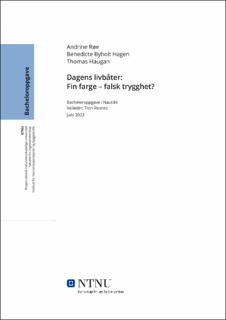| dc.contributor.advisor | Resnes, Tron | |
| dc.contributor.author | Hagen, Benedicte Byholt | |
| dc.contributor.author | Haugan, Thomas | |
| dc.contributor.author | Røe, Andrine | |
| dc.date.accessioned | 2023-07-18T17:20:34Z | |
| dc.date.available | 2023-07-18T17:20:34Z | |
| dc.date.issued | 2023 | |
| dc.identifier | no.ntnu:inspera:146718194:151075487 | |
| dc.identifier.uri | https://hdl.handle.net/11250/3080024 | |
| dc.description.abstract | Dagens konvensjonelle livbåter følger kravene LSA-koden har satt for utforming av sitteplasser. Disse kravene ble sist oppdatert i år 1997, og med dagens demografi og økende kroppsvekt undersøker oppgaven nærmere hvordan disse kravene stiller seg mot befolkningen og sjøfolk i Norge i dag.
Problemstillingen oppgaven belyser er: «Vil det være plass til gitt antall personer i livbåten som kapasitetsantallet tilsier i praksis?». Dette spørsmålet besvares med to delspørsmål. Første spørsmål er: «Er gjennomsnittsvekten fra LSA-koden representativ med dagens demografi?». For å besvare dette er det valgt å begrense oppgaven til demografien i Norge. Det andre spørsmålet er: «Hva skal til for å typegodkjenne livbåter?».
Informasjonen i oppgaven er hentet fra digitale oppslagsverk og semistrukturelle intervju av to intervjuobjekt. Det ble gjennomført en feltundersøkelse i forbindelse med testing av å fylle en livbåt til sitt maks kapasitetsantall. Med utgangspunkt i informasjonsinnhentingen, intervju og undersøkelsen vil metoden som benyttes i denne oppgaven være trianguleringsmetoden, da denne kombinerer både kvalitativ og kvantitativ metode.
Det kommer frem gjennom intervjuene at retningslinjene for typegodkjenning og testing av livbåter er tilfredsstillende. Typegodkjenningsprosessen tar for seg alt fra designfasen til konstruksjonsfasen, og oppfølging etter den har blitt tatt i bruk.
Oppgaven konkluderer med at kravene som stilles i LSA-koden bør oppdateres i samsvar med befolkningsutviklingen. Prognosene tilsier at befolkningen i Norge blir tyngre og større, og det vil være et behov for større dimensjonering av sitteplassene i livbåtene. | |
| dc.description.abstract | The design for seating spaces in conventional lifeboats follow the requirements described in the LSA-code. These requirements were last updated in 1997, and this thesis seeks to examine how these requirements apply with today’s demographics and an increasing body mass in the Norwegian population.
The thesis seeks to investigate: “Will it be enough space for the full number of people the capacity number of a lifeboat indicates in practice?”. This question is answered with two sub-questions. The first sub-question is: “Is the average weight from the LSA-code representative with the current demographic?”. To answer this question the thesis is confined to the demographic of Norway. The second sub-question is: “What requirements does a lifeboat need to satisfy to become type approved?”.
The information in this thesis is gathered from digital encyclopaedias and semi-structured interviews. A field study was carried out in conjunction with a max capacity test of a lifeboat. Based on the process of gathering information, the chosen research method is a hybrid method. A combination of quantitative and qualitative research methods have been chosen.
The interviews showed that the directions for type approval and testing of lifeboats is satisfactory. The type of approval process covers the phase of design to construction, and follow-up after it has been commissioned.
The thesis concludes that the requirements described in the LSA-code should be updated in accordance with population developments. Research indicates that the future population of Norway will become both heavier and larger. This means that there will be a need for larger dimensions of the seating spaces in the lifeboats. | |
| dc.language | nob | |
| dc.publisher | NTNU | |
| dc.title | Dagens livbåter: Fin farge – falsk trygghet? | |
| dc.type | Bachelor thesis | |
